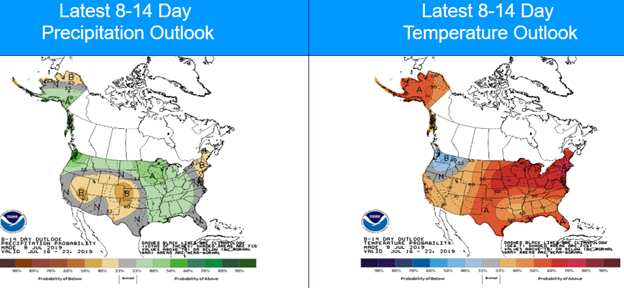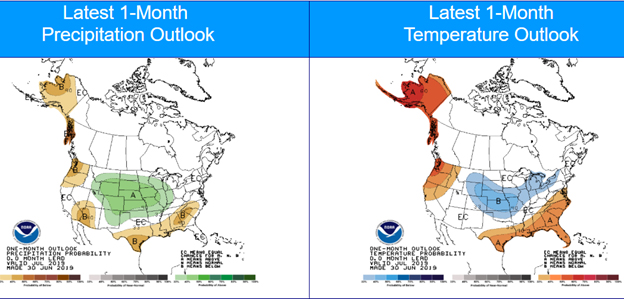Excess soil moisture is abating – but slowly, and more moisture could be on the way. In the 48 contiguous states, surplus topsoil now is reported on 15% of the cropland. This is down 5 percentage points from last week, but still well above the 8% surplus in topsoil at this same point last year. Likewise, subsoil moisture is in surplus supply on 17% of the acres, down from 20% last week but up from only 6% last year.
The percentage of topsoil that is short or very short increased from 12% last week to 15% this week, compared with 30% last year; moisture shortage in subsoil creeped up from 12% last week to 13% this week, but is very favorable compared with last year’s 32%.
| TOPSOIL |
Surplus
|
Adequate
|
Short / very short
|
| Iowa |
16
|
80
|
4
|
| Kansas |
13
|
81
|
6
|
| Nebraska |
12
|
84
|
4
|
| South Dakota |
31
|
68
|
1
|
| 48 states |
15
|
70
|
15
|
Crop development continues to lag, with only 30% of the corn silking and 10% of the soybeans blooming in the 18 reporting states. This compares with five-year averages of 22% and 32%.
|
Corn silking
week of July 7
|
Corn silking
average
|
Beans blooming
week of July 7
|
Beans blooming
average
|
| Iowa |
1
|
14
|
7
|
30
|
| Kansas |
19
|
38
|
7
|
20
|
| Nebraska |
2
|
16
|
10
|
37
|
| South Dakota |
0
|
6
|
3
|
31
|
| 48 states |
8
|
22
|
10
|
32
|
Corn condition, rated at 57% good/excellent, was up one percentage point from last week and about what the trade looked for. Soybeans’ good/excellent rating decreased one percentage point to 53%; the trade expected an increase of one to two points.
Grain sorghum heading is actually ahead of average in Nebraska (11% vs. 4%) and Kansas (5% vs. 4%). Meanwhile, South Dakota reports 0% is heading compared to a 15% average. Combined, the six reporting states stand at 22% heading, 2 points behind average.
Nebraska sorghum is rated 79% good/excellent. This is ahead of Kansas sorghum at 69% and South Dakota sorghum at 59%. For the six states, 83% is in the top categories. Very little is rated poor/very poor.
USDA’s supply and demand estimate on Thursday is the next indicator of where these crops may be headed, but it will be some time before there is any confidence in acreage or yield estimates. USDA is conducting another acreage survey this month as it attempts to get a handle on prevent-plant acres. Meanwhile, crop insurance claims are being logged as well.
Winter wheat
Wheat harvest is creeping along and has reached 47% in the 18 reporting states, well behind the 61% average. Kansas has cut 61% (average, 84%); Nebraska, 2% and South Dakota none (6%).
Long-range weather
The Climate Prediction Center’s 8 to 14 day outlooks indicate the likelihood is on the side of wetter and warmer than normal weather. The one-month outlook shrinks the area likely to have above-normal rainfall and suggests the center of the country will be cooler than usual.
Map source: Weather.gov



